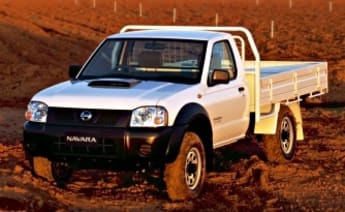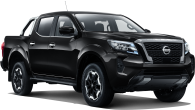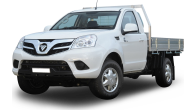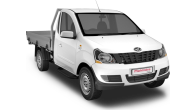What difference does a decade make? Everything from the ground-up aside from a few sections of chassis rail if you’re a Nissan Navara, with the new NP300 model hitting Australian shores this week.
Representing the first major Navara update since the D40 model arrived in 2005, a 10 year intermission is a long time in the automotive world. Most passenger car generations last no more than four years, but the Navara’s showroom stint is actually pretty standard for a light commercial ute. Other key examples include the regenerated Toyota HiLux and Mitsubishi Triton that have also appeared this year.
Age has mattered little for each of these cases, with the Navara being Nissan’s top-selling nameplate for the past nine years straight, the Triton outselling any other Mitsubishi by more than 2:1 in 2014, and the HiLux a firm number three in the overall market.
These automotive Betty White equivalents’ continued success has also come despite the category benchmark being reset over three years ago, with the advent of the Volkswagen Amarok and the arrival of the locally developed Ford Ranger and Mazda BT-50 mechanical twins.

The NP300 also has the unique task of replacing two distinct versions of the Navara, as it also supercedes the even older D22 design which sold alongside the D40 for its duration.
Given the love for both of these previous generations, Nissan is banking on the vastly redesigned NP300 to continue this success.
The Navara is responsible for 30 per cent of Nissan's - Australia’s seventh-biggest automotive brand in 2014 - business, so it’s kind of a big deal.
Value
Nissan is keen to spread the NP300 magic as widely as possible, with the range growing from 21 to 27 variants.
This covers DX, RX, ST, and ST-X trim levels, single, king and dual cab body styles, one petrol and two diesel engines, two transmissions and a choice of two or four-wheel drive.
RELATED: Full NP300 Navara dual cab price and spec details
Nissan has so far only confirmed pricing for the 14 dual cab models, and the spectrum of $26,490-$54,490 differs little from the D40.
All bring extra features to boost value, but only the ST-upwards get a reversing camera fitted as standard. The top ST-X is the only variant to get rear (only) parking sensors, but you also get satnav, dual-zone climate control, perforated leather trim, heated front seats and mirrors, sunroof, and a plastic tray liner.
Nissan has also adjusted the Navara’s service schedule to 12month/20,000km intervals, which has significantly improved the cost of the capped price servicing. However, at $1784 for the first three years for a dual cab diesel auto, it’s still well above the segment average.
Dual-cab light commercials are perhaps the most diversely used vehicles on the market
The NP300 carries Nissan’s standard 3yr/100,000km warranty, with three years of 24hr roadside assistance also included.
Design
Dual-cab light commercials are perhaps the most diversely used vehicles on the market, varying from traditional tradies to recreational four-wheel drivers, those who tow heavy loads, and increasingly as family car alternatives to large SUVs.
Balancing all of these needs is a difficult task for engineers, and the NP300 development included over a million kilometres and 40,000 individual tests.
We’ve only driven the dual cab 4x4 lineup for now, with the rest of the range held back til September due to production delays in Nissan’s new plant in Thailand. All Australian Navara models will now be Thai-sourced, unlike the variety of nations that produced the D40 during its lifetime.
Unlike most new models, the new dual cab is actually slightly smaller than before, dropping 50mm from the wheelbase and 41mm from its overall length.
Despite this external shrinkage, the cargo bed is only 8mm shorter at 1511mm, the same width at 1560mm and 17mm shallower at 457mm.
All dual cab models step up to the industry benchmark 3.5 tonne braked towing capacity, and join only the SsangYong Actyon Sports in using a more car-like coil spring rear suspension setup. All other NP300 Navaras will use a more ute-traditional leaf spring rear suspension design.
Dual cab payload figures are actually up slightly – now 930-1034kg depending on spec, from 828-1011kg – but towball download ratings are down. For an NP300 dual cab, a 300kg download reduces the Gross Vehicle Mass (GVM) by 410kg, compared to the D40 models 200kg GVM adjustment.
Off road credentials have slightly improved with the 4x4 dual cab’s slightly massaged proportions, with a 2 degree gain for approach, rampover and departure angles. ST-X models also now come with a rear diff lock.
A snorkel would be a wise investment for anyone wishing to exploit these figures, as the NP300’s maximum wading depth is still just 450mm. The Ranger and BT-50’s 800mm figure is still the segment benchmark.
On the inside, the NP300’s interior is light years ahead of the D40, with tough but more passenger car-like plastic textures pushing it right up there with the best in the segment.
The back seat has plenty of room for three adults, with a good backrest angle and twin storage cavities beneath the seat base.
There’s still no ISOFIX child seat mounts or reach adjustment to the steering wheel, however.
All trim levels get three 12V power sources in the cabin, plus a fourth in the tray tub.
All bar the top ST-X get four tie-down points in the tray, which the top-spec replaces with the clever Utili-Track sliding tie down system.
Nissan has a full suite of optional genuine accessories available from launch, and the big aftermarket brands are ready with a range of bull bars etc thanks to the NP300’s launch in Thailand 10 months ago.
Engines / Transmissions
The new dual cab is available with two versions of a new Renault/Nissan co-developed 2.3-litre turbodisesel engine, with the 120kW/403Nm YS23DDT powering the RX trim level, and the 140kW/450Nm YS23DDTT twin-turbo version beneath the ST and ST-X variants. Both engines deliver their best over the same rev range, with max torque from 1500-2500rpm and max power from 3750rpm. There’s no sign of a replacement for the V6 turbodiesel found in the ST-X 500 D40 flagship for now.
A petrol option returns for NP300, with the base DX 4x2 equipped with a 122kW/238Nm version of the QR25DE 2.5-litre four cylinder used in the X-Trail and Altima.
All dual cab Navara models come with a new six-speed manual transmission as standard, and step up to the seven-speed Jatco-sourced torque converter auto found in several other Nissan models for an extra $2500.
Nissan expects the manual transmission to remain the most popular choice in the lesser grades, but more mainstream buyers of the ST-X to be split 50:50 between auto and manual.
The new Navara is significantly more refined than the utes of old
Perhaps the biggest news for the new drivetrains is the diesel engines’ class-leading fuel efficiency, with the manual 4x2 consuming as little as 6.3L/100km combined.
The twin turbo version is 0.1L/100 more efficient across the board according to the official figures, with the automatic adding 0.5L/100km, and 4x4 just 0.2L/100 more again.
The petrol DX 4x2 uses 9.9L/100km in manual guise, and 9.7L/100km with the auto.
Driving
Like most new light commercials, the new Navara is significantly more refined than the utes of old, reflecting the fact that more and more people are buying them as family cars, or as an alternative to a big SUV.
We spent several hundred kilometres driving it around town, on the highway, through twisty mountain roads and even corrugated outback trails.
The new diesel engine is quiet and smooth, even from cold, and makes plenty of urge from down low in either single turbo or the higher spec twin turbo guises.
All of our driving was without a load in the tray, but even still, the new coil sprung rear end makes for very good ride for a light commercial. There’s an overall tightness to the design, with no rattles on any terrain.
It’s not light years ahead of the Ranger/BT-50 or Amarok, but it’s a setup that you could easily live with every day, and not likely to trouble children on the back seat.
The steering uses hydraulic assistance for reasonable feel, but there’s still plenty of turns from lock to lock. This isn’t really an issue under general driving once you’re used to it, but can be annoying during three point turns.
Like many utes, the shallow rear window restricts rearward visibility, but the taller rear bulkhead aids load carrying depth.
The Navara is certainly once again one of the best choices in the segment
This a ute you could comfortably spend all day aboard on the highway, and the auto ticks over at just 1800rpm at 100km/h. The manual sits at 2000rpm in sixth, which would likely give a real-world highway economy advantage to the auto.
The manual shift is quite good for a working ute, but the narrow gate could take some getting used to. If it was our money, we’d be opting for the slick and fuss-free auto. The extra investment from new would likely pay dividends come trade-in time too.
Safety
Nissan expects the NP300 Navara to step up to a maximum five star ANCAP safety rating – from the four star D40 and three star D22 – and is due to be tested in the coming weeks.
All trim levels come with front, side and full-length curtain airbags, plus a driver’s knee bag, but there’s no sign of the forward collision warning, blind spot or lane guidance due for the Ranger’s update, and tipped for the new HiLux.
Nissan Navara 2015: ST (4X4)
| Engine Type | Diesel Turbo 4, 2.3L |
|---|---|
| Fuel Type | Diesel |
| Fuel Efficiency | 7.0L/100km (combined) |
| Seating | 5 |
| Price From | $22,220 - $27,500 |
| Safety Rating |
|
Verdict
The Navara is certainly once again one of the best choices in the segment. Whether it’s as good overall as the updated Ranger and new HiLux remains to be seen, but it’s a huge improvement over the old models.
Pricing Guides

Range and Specs
| Vehicle | Specs | Price* |
|---|---|---|
| ST-X | 2.3L, Diesel, 6 SPEED MANUAL | $21,340 - $27,060 |
| ST-X | 2.3L, Diesel, 7 SPEED AUTOMATIC | $25,080 - $31,020 |
| ST-X (4X4) | 2.3L, Diesel, 6 SPEED MANUAL | $23,870 - $29,480 |

.jpg)
.jpg)
.jpg)
.jpg)
.jpg)
.jpg)
.jpg)
.jpg)
.jpg)
.jpg)
.jpg)
.jpg)
.jpg)
.jpg)
.jpg)
.jpg)
.jpg)
.jpg)
.jpg)
.jpg)
.jpg)
.jpg)
.jpg)
.jpg)
.jpg)
.jpg)
.jpg)
.jpg)











.jpg)

